Physical Address
304 North Cardinal St.
Dorchester Center, MA 02124
Chondroma: a benign intramedullary neoplasm consisting of mature hyaline cartilage ▸ it is commonly centrally located (and then referred to as an enchondroma)
It is the 2 nd commonest benign chondral lesion (after an osteochondroma)
An incidental finding ▸ a pathological fracture (60%) ▸ pain in the absence of a fracture or a rapid size increase is potentially malignant
Age: 10–80 years (M = F)
The tubular bones of the hands (40–65%): proximal phalanges > metacarpals or middle phalanges ▸ femur, tibia and humerus (25%) ▸ small bones of the feet (7%)
A metaphyseal or diaphyseal location (rarely located within the epiphysis) ▸ often eccentric
It is not found within the skull (it is only found within bones that are formed by endochondral ossification)
A well-defined oval or lobulated eccentric lytic lesion ▸ cortical expansion and chondral (popcorn) type calcification ▸ the overlying cortex may be thin and scalloped ▸ a narrow or sclerotic zone of transition ▸ no periosteal reaction (unless fractured) ▸ a solitary lesion in 75%
‘Reverse Madelung’ deformity: a short distal ulna
Lobular margin ▸ T1WI: intermediate SI ▸ T2WI: high SI (due to the water content of hyaline cartilage) ▸ punctate areas of signal void (matrix mineralization) ▸ there is a hypointense rim with septations ▸ T1WI + Gad: septal enhancement
No increased uptake
Differentiation between a large enchondroma + grade 1 chondrosarcoma can be difficult ▸ lesion size >5–6 cm and deep endosteal scalloping are suggestive of chondrosarcoma
Rare and occurs in children and young adults ▸ it affects the long bone metaphyses (proximal humerus ▸ femur, tibia and the tubular bones of the hands and feet) ▸ no malignant potential ▸ the differential includes a periosteal chondrosarcoma/periosteal osteosarcoma
XR: a 1–3 cm well-defined area of cortical erosion ▸ a mature periosteal reaction ▸ chondral-type calcification (50%) ▸ rarely a thin external shell of bone is present
MRI: T2WI: a lobulated high SI mass adjacent to but not infiltrating the underlying cortex
Characterized by multiple enchondromas ▸ sporadic (and not inherited) ▸ usually unilateral ▸ bone growth may be impeded (with bowing or angulation)
Malignant change (5–30%) ▸ an associated risk of a glioma, pancreatic or ovarian carcinoma
A rare condition characterized by multiple enchondromas and soft tissue haemangiomas (phleboliths) ▸ unilateral in 50%
Malignant change (20%) ▸ usually > 40 years
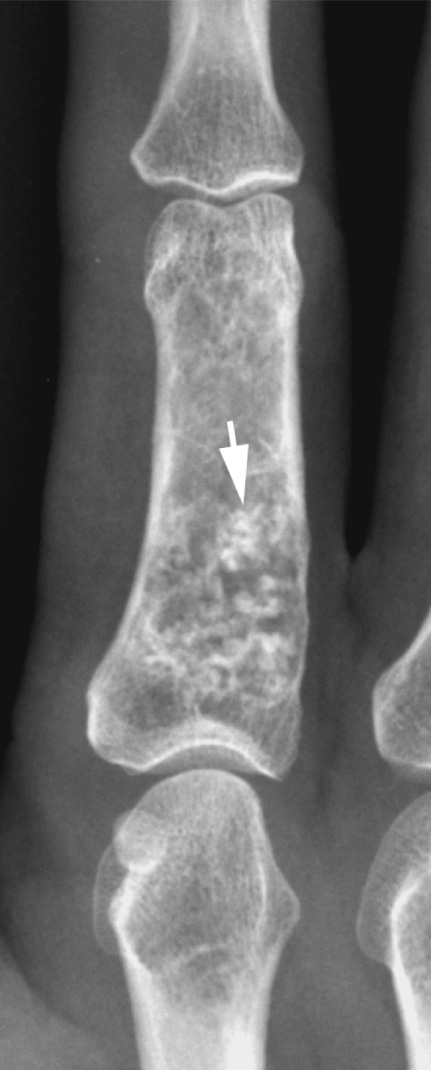
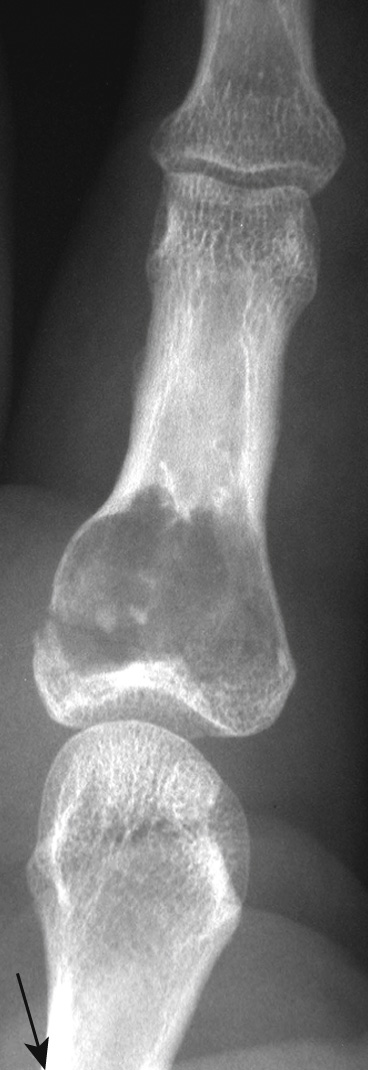
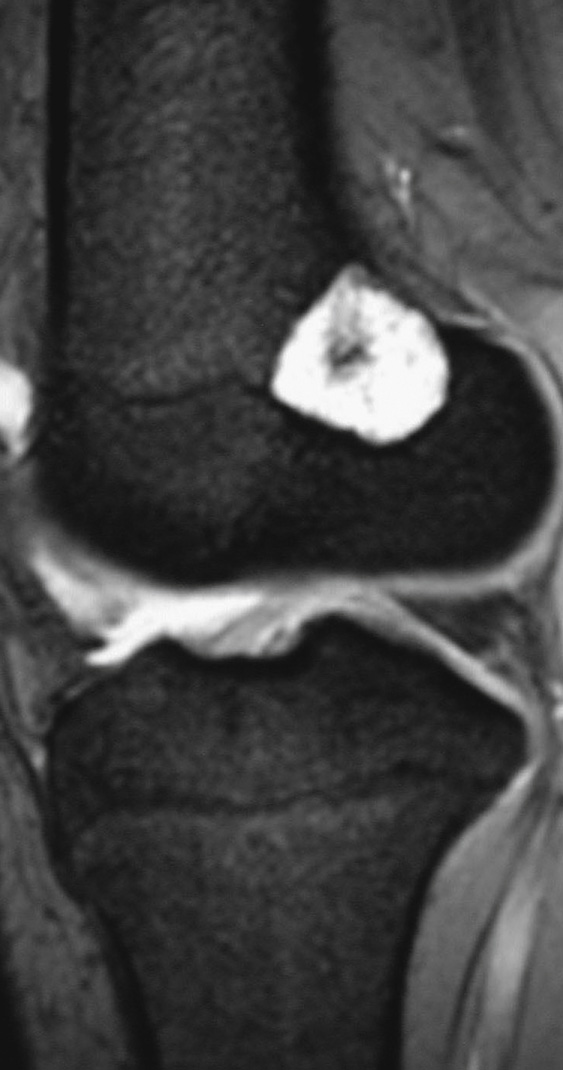
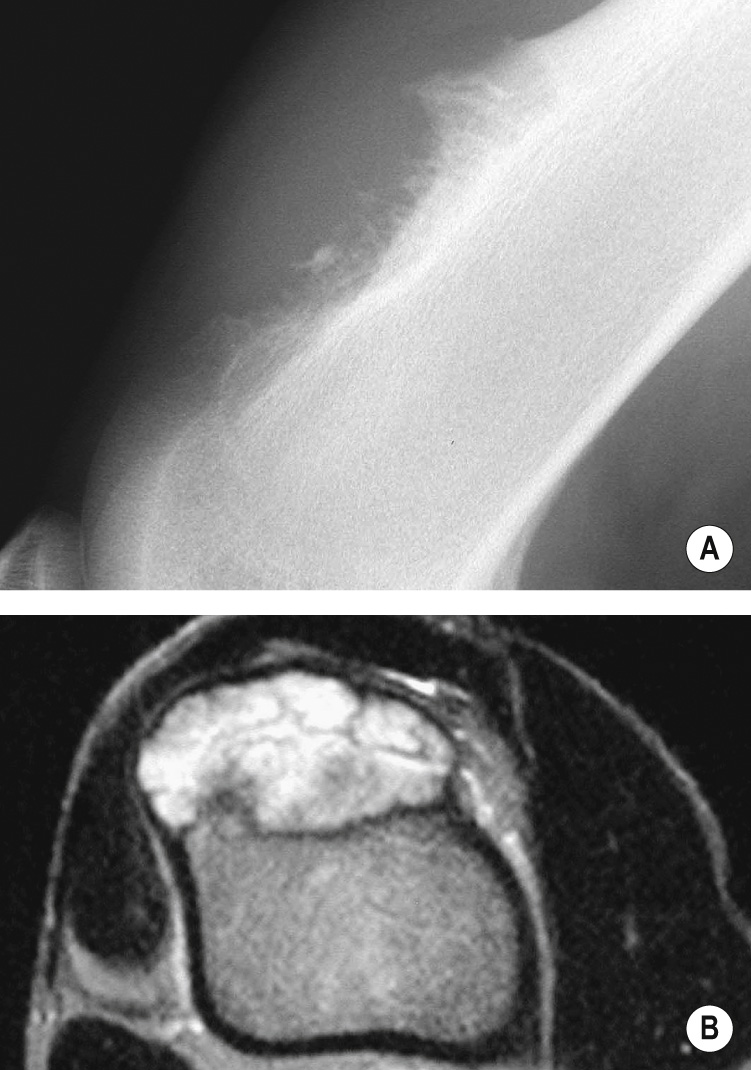
A benign tumour composed of immature myxoid mesenchymal tissue with early cartilagenous differentiation
Pain and swelling (it can be asymptomatic)
75% of patients present between 10 and 30 years of age (75%) ▸ (M : F, 2 : 1)
60% are found within the long bones (25% are within the upper ![]() of the tibia) ▸ 40% are found within the flat bones (10% within the ilium) ▸ 17% are found within the small tubular bones of the hands and feet ▸ metaphyseal and eccentric in the medulla
of the tibia) ▸ 40% are found within the flat bones (10% within the ilium) ▸ 17% are found within the small tubular bones of the hands and feet ▸ metaphyseal and eccentric in the medulla
An eccentric lobulated metaphyseal lytic lesion arising within the medulla ▸ it can cross into the epiphysis ▸ an associated well-circumscribed sclerotic border with thinning and expansion of the cortex ▸ the lesion long axis parallels the bone long axis ▸ periosteal reaction or soft tissue extension is uncommon ▸ matrix calcification in seen in 12% of cases
There are no characteristic features
Increased uptake
Differential: chondrosarcoma ▸ adamantinoma ▸ fibrous dysplasia ▸ ABC
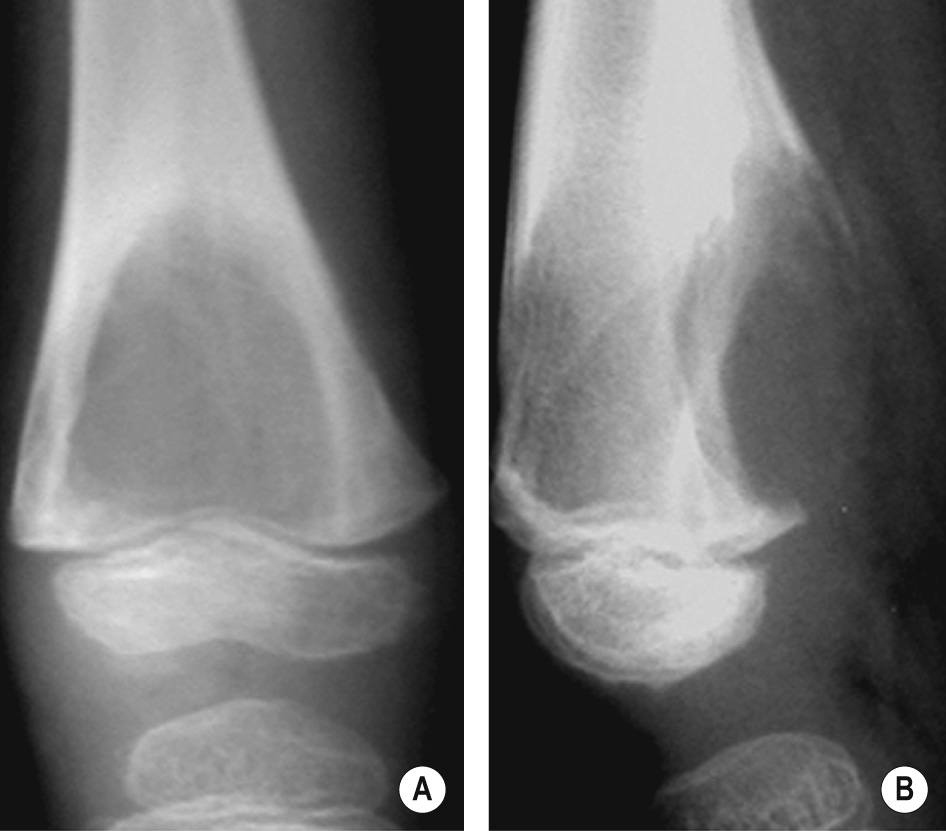
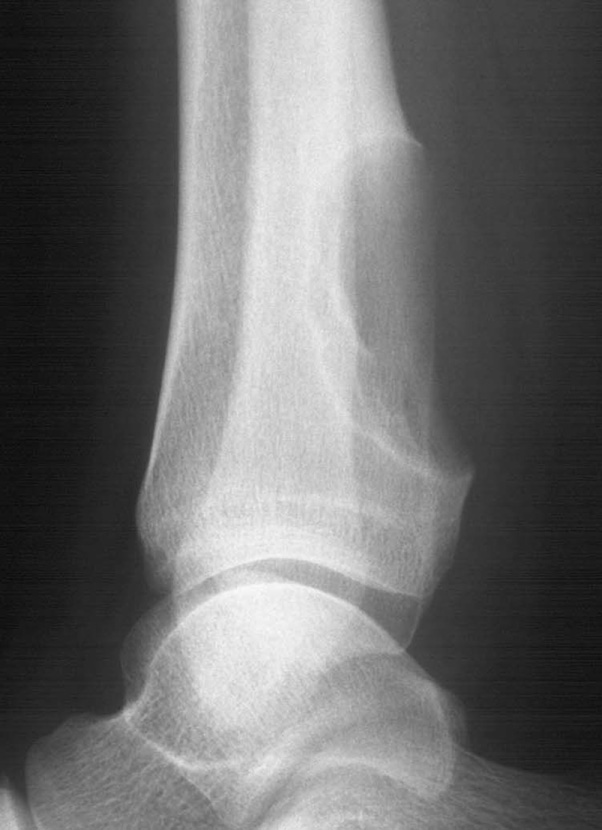
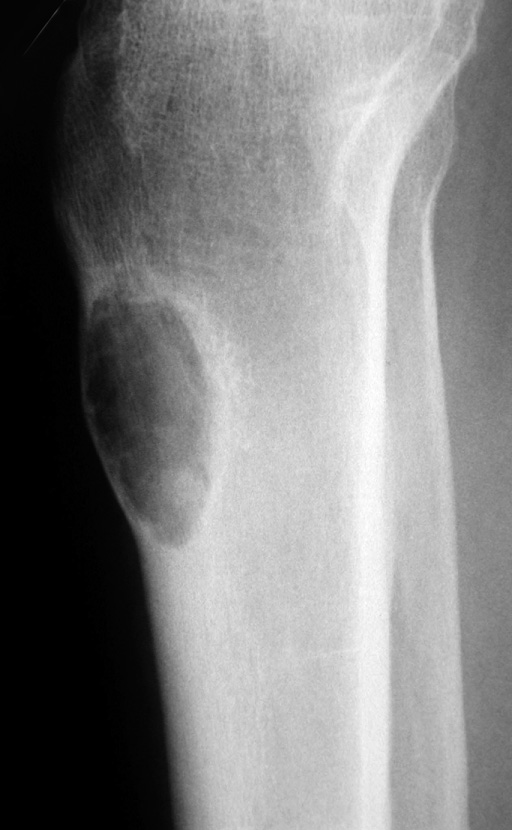
A cartilage-capped exostosis (representing a bony outgrowth) ▸ usually a developmental anomaly ▸ it possesses its own growth plate and will stop growing with skeletal maturity
The most common benign bone lesion
It presents between 2 and 60 years (M : F, 2 : 1)
It can present with mechanical problems: an enlarging mass ▸ pressure on any adjoining structures (e.g. nerves or blood vessels) ▸ bursa formation (due to irritation of local soft tissues)
Rarely the stem can fracture
The long bones – especially around the knee (35%) ▸ the proximal humerus or femur ▸ the flat bones (e.g. the ilium or scapula)
Lesions are initially metaphyseal but migration to the diaphysis occurs over time (classically pointing away from the joint)
A continuous bony outgrowth from a normal cortex ▸ it can have a long slim neck (pedunculated) or be broad based (sessile) ▸ the marrow cavity extends into the exostosis (essential feature for diagnosis) ▸ the cartilage cap develops punctuate calcification with age
These allow assessment of the cartilage cap – it should be < 5 mm (T2WI: high SI)
There will be variable activity
Differential: periosteal chondroma ▸ parosteal osteosarcoma
Chondrosarcomatous change within the cartilage cap (occurring in <1% of cases) should be suspected if:
There is an increase in pain or size (particularly after skeletal maturation)
If the cartilage cap measures >1 cm (CT) or >2 cm (MRI)
The development of ill-defined margins
A rare autosomal disorder with multiple osteochondromas occurring particularly at the ends of the long bones, ribs, scapulae and iliac bones (they may be larger than in the solitary form) ▸ this may lead to shortened or deformed limbs (e.g. a reverse Madelung deformity with a short distal ulna) ▸ the metaphyses can be widened and dysplastic
Vertebral involvement is rare ▸ the cranial vault is spared ▸ malignant degeneration in 3–5%
A rare, tumour-like disorder
Calcified masses arise adjacent to the cortex of the small bones of the hands and feet – there is no continuity between the lesion and the underlying bone ▸ there is no cartilaginous cap but it can resemble an osteochondroma
Differential: soft tissue chondroma ▸ florid reactive periostitis
Irregular overgrowth of part of an epiphysis which lies on one side of a single limb (resembling an osteochondroma) ▸ the leg is commonly affected
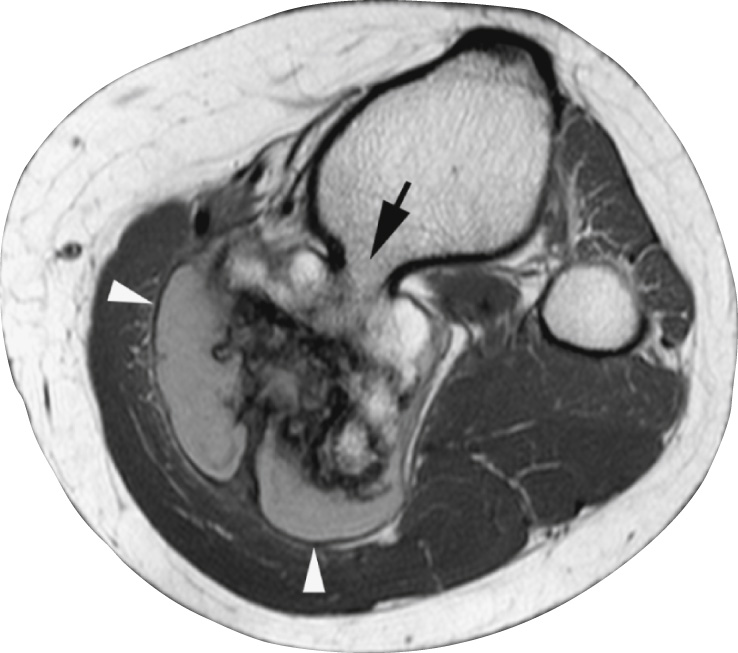
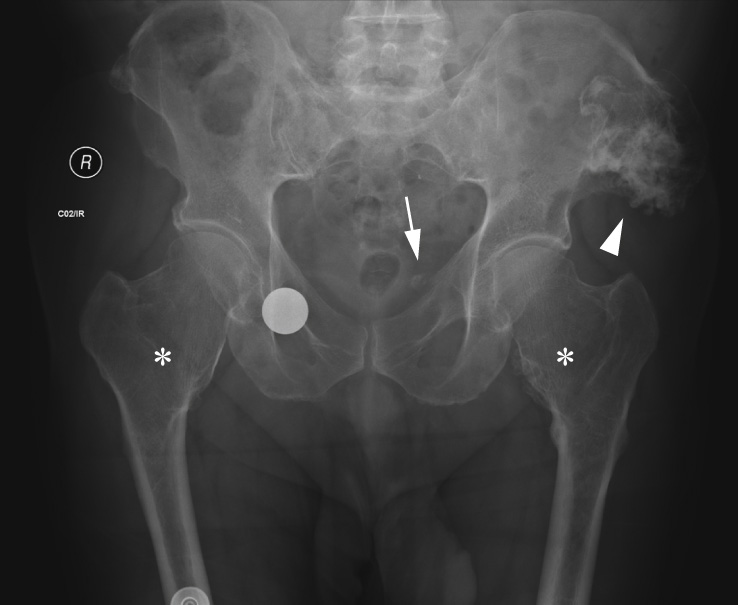
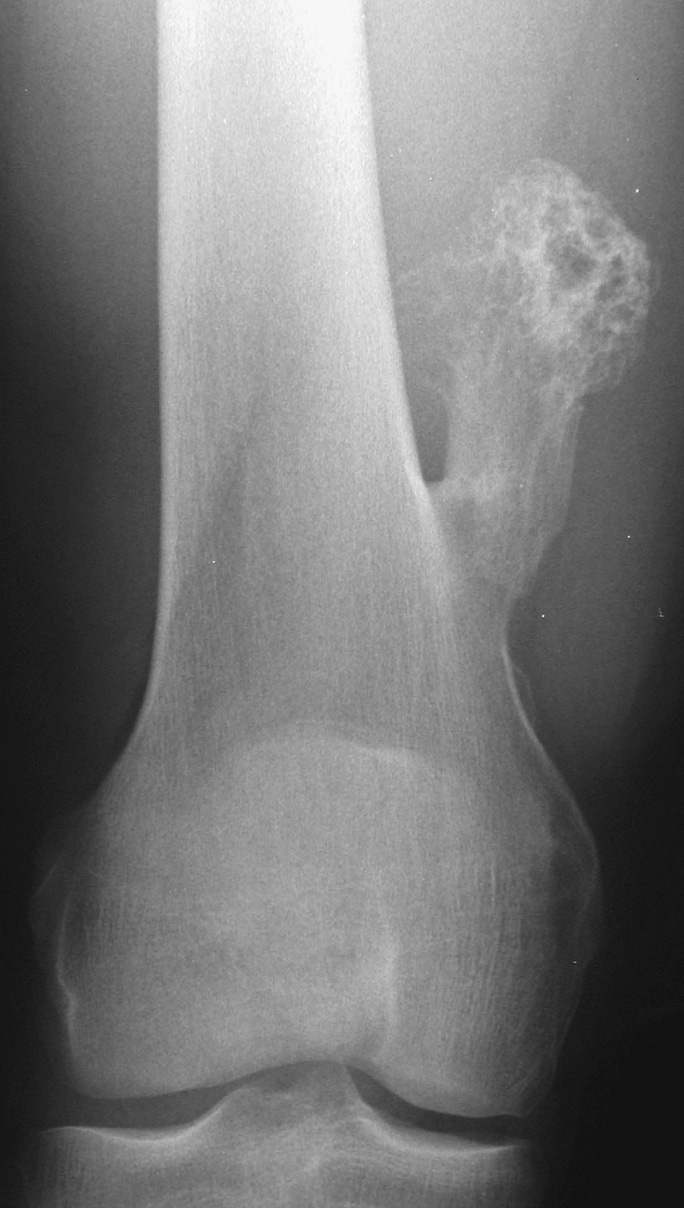
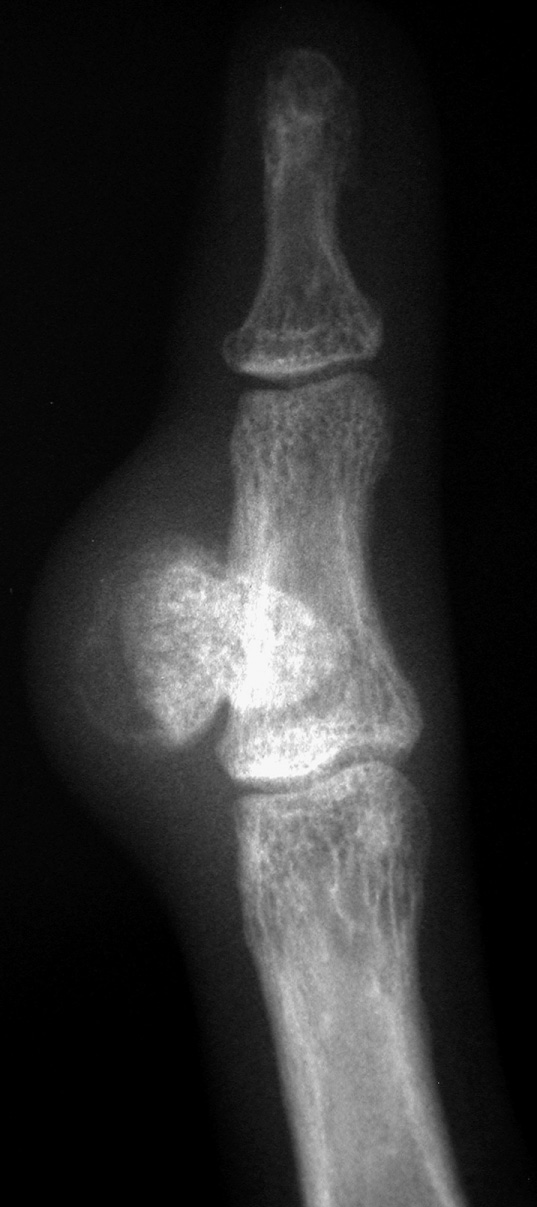
A benign cartilage tumour with proliferation of immature cartilage cells (1% of all bone tumours)
80–90% occur between 5 and 25 years (M : F, 3 : 1)
It presents with joint pain (± a synovial reaction) ▸ commonly presents as a monoarthropathy (typically located in the epiphyses and provoking a synovial reaction)
It is usually seen in skeletally immature patients, affecting the long bone epiphyses (40% are seen around the knee, and 33% within the proximal femur)
Also found within apophyses and sesamoid bones (epiphyseal equivalents) such as the femoral greater trochanter and patella (the commonest patella tumour)
It usually affects the calcaneus or talus in the foot
The flat bones are mostly affected if >30 years old
An eccentric spherical or lobular lytic lesion with a fine sclerotic margin centred within the epiphysis (40%) ▸ it extends into the metaphysis (55%) with partial closure of the growth plate
Matrix mineralization (30%) ▸ linear periosteal reaction (30–50%)
T1WI: intermediate SI ▸ T2WI: variable SI including fluid levels due to secondary aneurysmal bone cyst change (15%) ▸ there is associated marrow and soft tissue oedema ▸ there may be a reactive joint effusion
A rare variant associated with cortical destruction and soft tissue involvement ▸ rarely associated with lung metastases
Differential of a lytic epiphyseal lesion:
Children: Brodie's abscess
Adults: subchondral cyst ▸ clear cell chondrosarcoma
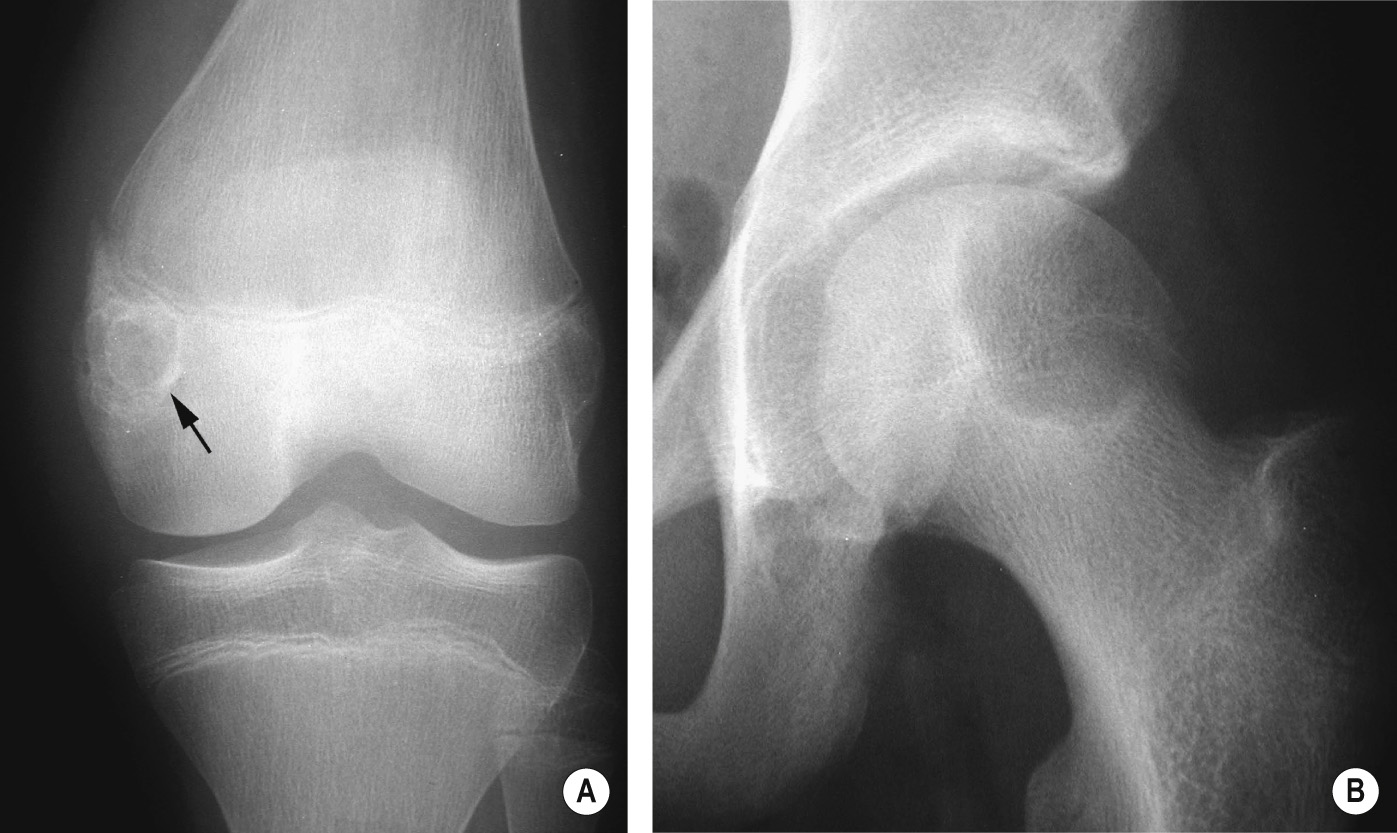
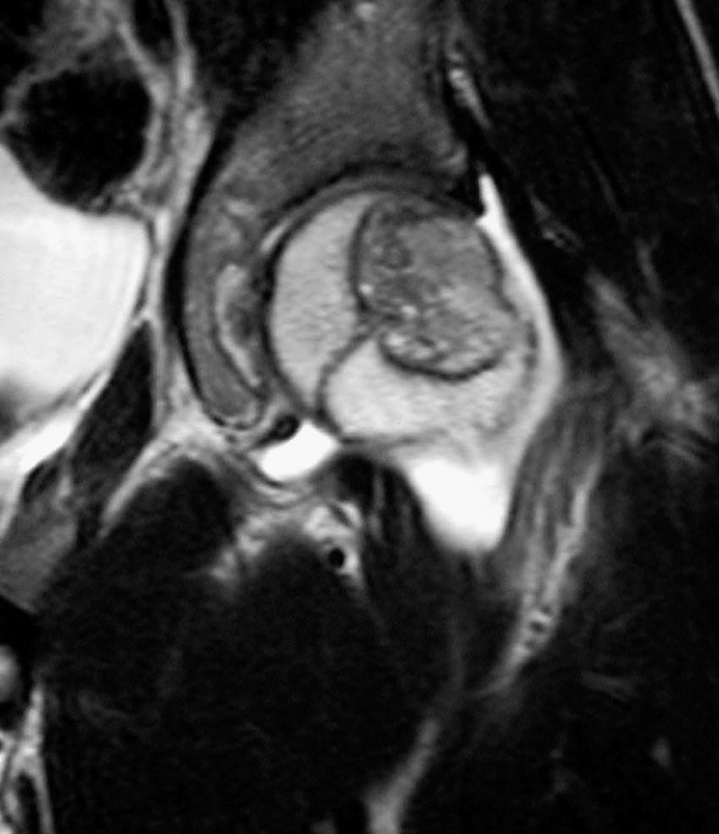
A benign bone tumour producing osteoid and woven bone ▸ it is histologically similar to an osteoid osteoma, but is differentiated by its size (> 1.5–2 cm) ▸ tends to show a more aggressive growth pattern ▸ does not resolve spontaneously
Any pain is usually more chronic and less severe than with an osteoid osteoma (and is rarely relieved by aspirin) ▸ there can be a painful scoliosis (with tumour at the concavity apex)
80% of cases present at < 30 years of age (M : F, 2–3 : 1)
40–50% are within the spine and sacrum – 90% are eccentrically located within the neural arch with a painful scoliosis (± expansion or absence of the pedicle) ▸ potential extraosseous extension
Other major sites: the diaphyses or metaphyses of the long bones (commonly the humerus)
A predominantly lytic lesion (>2 cm) ▸ larger lesions have greater matrix mineralization and may expand the bone with surrounding reactive sclerosis
This often reveals occult calcification (punctate/nodular/generalized)
Reactive marrow and soft tissue changes (which may extend across several vertebrae) dominate ▸ there may also be secondary ABC changes ▸ T1WI: low or intermediate SI ▸ T2WI: intermediate or high SI ▸ T1WI + Gad: enhancement
This is always positive
An osteoblastoma may produce an extracortical mass causing spinal cord compression with a soft tissue component
‘Aggressive osteoblastoma’: a locally aggressive lesion which is commonly within the sacrum and capable of producing metastases
Differential (long bones): Brodie's abscess ▸ chondromyxoid fibroma ▸ Langerhans' cell histiocytosis
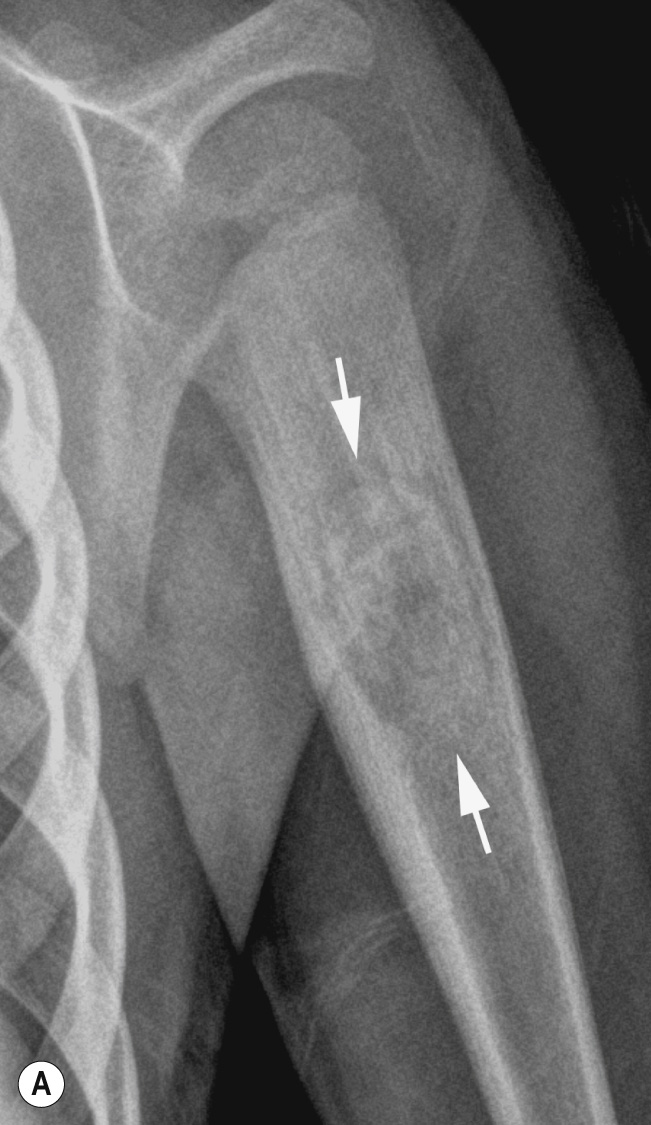
A congenital developmental focus of medullary cortical bone
An asymptomatic incidental finding
It is commonly seen within the pelvis, femur and other long bones
A dense sclerotic focus with a spiculated margin blending with the trabeculae of adjacent bone
It is hypointense on all sequences (equivalent to cortical bone)
Unlike a sclerotic metastasis, it will tend to have straight edges and the very dense bone can cause adjacent susceptibility artefacts
There is usually no uptake (25% of giant bone islands show increased uptake)
An autosomal dominant condition with multiple bone islands located in a periarticular distribution ▸ they can appear either round (osteopoikilosis) or elongated (osteopathia striata) in shape
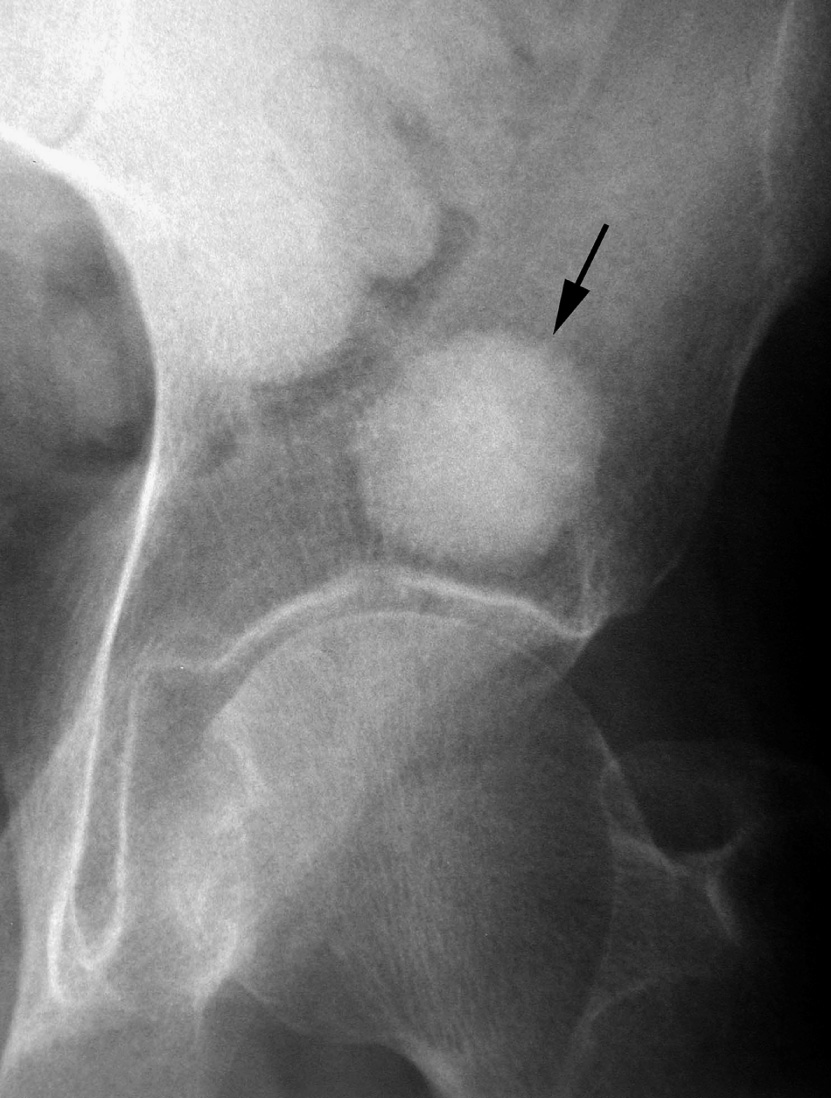
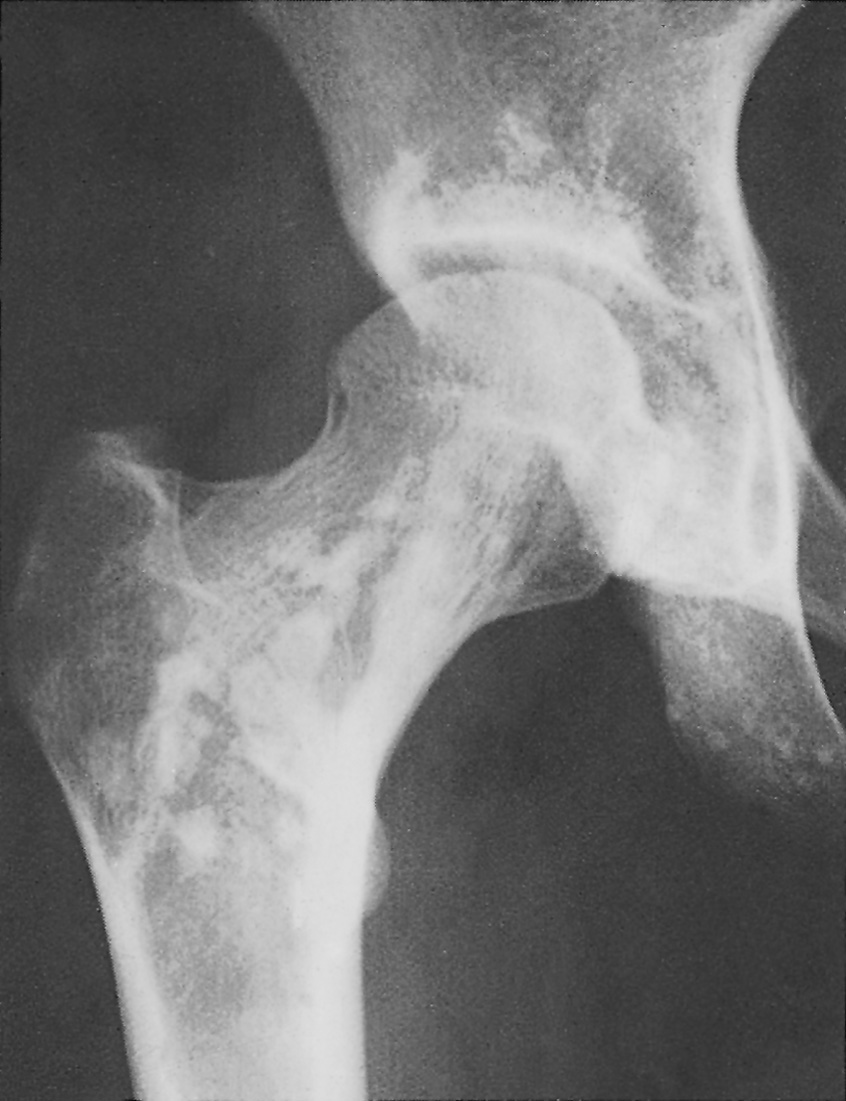
A slow-growing tumour consisting of predominantly cortical or, less often, cancellous bone ▸ it represents a dysplastic developmental anomaly
It is usually asymptomatic, although it can affect sinus drainage (leading to mucocoele formation) ▸ it can also cause CSF rhinorrhoea, pneumocephalus or meningitis
Cortical (ivory) osteomas commonly affect the paranasal sinuses (frontal and ethmoid > sphenoid sinuses) ▸ it is less often found within the mandible, long bones or spine (causing backache)
A homogeneous smooth dense lesion with a well-defined spherical margin ▸ it is attached to underlying bone ▸ it rarely exceeds 2–3 cm diameter
Multiple osteomas occur in Gardner's syndrome

A benign hamartoma affecting the cortex (80%), medullary cavity or subperiosteum ▸ it produces osteoid and woven bone
Become a Clinical Tree membership for Full access and enjoy Unlimited articles
If you are a member. Log in here